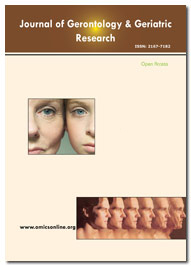ఇండెక్స్ చేయబడింది
- J గేట్ తెరవండి
- జెనామిక్స్ జర్నల్సీక్
- సేఫ్టీలిట్
- RefSeek
- హమ్దార్డ్ విశ్వవిద్యాలయం
- EBSCO AZ
- OCLC- వరల్డ్ క్యాట్
- పబ్లోన్స్
- జెనీవా ఫౌండేషన్ ఫర్ మెడికల్ ఎడ్యుకేషన్ అండ్ రీసెర్చ్
- యూరో పబ్
- గూగుల్ స్కాలర్
ఉపయోగకరమైన లింకులు
ఈ పేజీని భాగస్వామ్యం చేయండి
జర్నల్ ఫ్లైయర్

యాక్సెస్ జర్నల్స్ తెరవండి
- ఆహారం & పోషకాహారం
- ఇంజనీరింగ్
- ఇమ్యునాలజీ & మైక్రోబయాలజీ
- క్లినికల్ సైన్సెస్
- జనరల్ సైన్స్
- జెనెటిక్స్ & మాలిక్యులర్ బయాలజీ
- నర్సింగ్ & హెల్త్ కేర్
- న్యూరోసైన్స్ & సైకాలజీ
- పర్యావరణ శాస్త్రాలు
- ఫార్మాస్యూటికల్ సైన్సెస్
- బయోఇన్ఫర్మేటిక్స్ & సిస్టమ్స్ బయాలజీ
- బయోకెమిస్ట్రీ
- మెటీరియల్స్ సైన్స్
- మెడికల్ సైన్సెస్
- రసాయన శాస్త్రం
- వెటర్నరీ సైన్సెస్
- వ్యవసాయం మరియు ఆక్వాకల్చర్
- వ్యాపార నిర్వహణ
నైరూప్య
A Study of Heart Failure Patients and their Blood Pressure Trends Preceding Dementia Diagnosis
Wilson CK, Pangle AK, Wei JY, Azhar G
Introduction: Blood pressure and perfusion of the brain are central components of neurological health that are often influenced by Heart Failure. However, the connection between blood pressure and the development of dementia is not clearly understood.
Aim of the study: The aim of this retrospective study was to assess blood pressure trends in older heart failure patients and evaluate whether they developed dementia over the course of a five-year period.
Methods: This retrospective case-control study analyzed blood pressure changes preceding the diagnosis of dementia in patients over the age-of-60. Blood pressures were obtained from the date of dementia diagnosis, and then one-year and five years before diagnosis. Study “controls” were age-matched patients without dementia, using the mean-age-of dementia diagnosis as the first data point.
Results: 67.2% of patients with a dementia diagnosis had experienced a decrease in systolic pressure up to 5-years prior to their diagnosis, as compared to 46.6% of patients who had not been diagnosed by the same age. Similarly, in the one-year preceding the diagnosis, 62.7% of patients with dementia showed a decreasing systolic pressure over the time period, as compared to 50.0% of those who did not develop dementia. Additionally, there was a significant difference (p<0.001) in the dementia rates between African American and Caucasian subgroups (55.0% African Americans vs. 31.0% Caucasians).
Conclusions: Patients with dementia were more likely to have decreasing systolic pressure trends compared to age-matched patients without dementia and appeared to have significantly lower systolic pressures one-year-before dementia diagnosis. Lower systolic pressure can potentially reduce the perfusion pressure of the brain and cause subtle cerebral ischemia, leading to cognitive decline. It is very important that healthcare providers monitor these trends and risk factors as they manage blood pressures in geriatric patients.